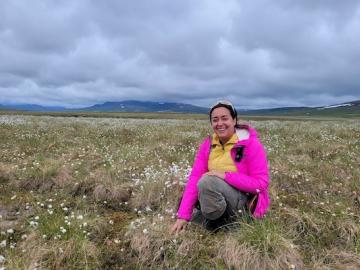Filter News
Area of Research
- (-) Biology and Environment (52)
- (-) Biology and Soft Matter (1)
- (-) National Security (25)
- Advanced Manufacturing (2)
- Building Technologies (2)
- Clean Energy (49)
- Computational Biology (1)
- Computer Science (1)
- Electricity and Smart Grid (1)
- Functional Materials for Energy (2)
- Fusion and Fission (15)
- Isotopes (3)
- Materials (43)
- Materials for Computing (6)
- Neutron Science (14)
- Renewable Energy (1)
- Supercomputing (39)
News Topics
- 3-D Printing/Advanced Manufacturing (4)
- Advanced Reactors (1)
- Artificial Intelligence (6)
- Big Data (3)
- Bioenergy (15)
- Biology (26)
- Biomedical (3)
- Biotechnology (3)
- Buildings (2)
- Chemical Sciences (8)
- Clean Water (2)
- Climate Change (19)
- Composites (2)
- Computer Science (8)
- Coronavirus (3)
- Critical Materials (1)
- Cybersecurity (5)
- Decarbonization (9)
- Energy Storage (4)
- Environment (25)
- Exascale Computing (2)
- Frontier (2)
- Grid (5)
- High-Performance Computing (5)
- Hydropower (5)
- Machine Learning (6)
- Materials (4)
- Materials Science (2)
- Mercury (1)
- Microscopy (6)
- Nanotechnology (2)
- National Security (13)
- Net Zero (1)
- Neutron Science (2)
- Nuclear Energy (1)
- Partnerships (3)
- Physics (1)
- Polymers (1)
- Security (3)
- Simulation (1)
- Summit (3)
- Sustainable Energy (9)
- Transformational Challenge Reactor (1)
- Transportation (1)
Media Contacts

ORNL has provided hydropower operators with new data to better prepare for extreme weather events and shifts in seasonal energy demands caused by climate change.

In human security research, Thomaz Carvalhaes says, there are typically two perspectives: technocentric and human centric. Rather than pick just one for his work, Carvalhaes uses data from both perspectives to understand how technology impacts the lives of people.

A new paper published in Nature Communications adds further evidence to the bradykinin storm theory of COVID-19’s viral pathogenesis — a theory that was posited two years ago by a team of researchers at the Department of Energy’s Oak Ridge National Laboratory.

Though Scott Stewart recently received an Early Career Award from the Institute of Nuclear Material Management, he is regarded as a seasoned professional in the nuclear field with over 10 years of experience.

When Hurricane Maria battered Puerto Rico in 2017, winds snapped trees and destroyed homes, while heavy rains transformed streets into rivers. But after the storm passed, the human toll continued to grow as residents struggled without electricity for months. Five years later, power outages remain long and frequent.

With wildfires increasing in scope and intensity around the world, Fernanda Santos’ research into how such calamities affect soil carbon storage has taken on new urgency.

Global carbon emissions from inland waters such as lakes, rivers, streams and ponds are being undercounted by about 13% and will likely continue to rise given climate events and land use changes, ORNL scientists found.

Countries around the world have unique languages, cultures, food, entertainment and governments. Yet, more than 170 countries are finding common ground in an unlikely field: nuclear material and science.

Five technologies invented by scientists at the Department of Energy’s Oak Ridge National Laboratory have been selected for targeted investment through ORNL’s Technology Innovation Program.

When Matt McCarthy saw an opportunity for a young career scientist to influence public policy, he eagerly raised his hand.




